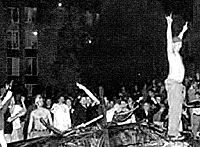 Introduction
Introduction
I am very pleased to have the opportunity to review and revise these rules in the light of a further 18 years game design experience. The first thing is that I must admit, my view of the theoretical model of riots has not altered substantially - if anything is has been reinforced by a study of events since the rules were first written in 1983, the Miner’s Strike, the LA Riots, The Trafalgar Square Poll Tax Riot, Broadwater Farm to name just a few.
These rules are designed to simulate the events and actions of a major public disturbance of the type seen during the post-war years in the Western world.
It can be argued that this is not really a wargame in the classic sense. It is not about Clauswitzian war, but, there are ‘two or more opposing forces’ as found in the NATO definition. In that it is undoubtedly a conflict simulation I suggest that it can properly belong to the broad class of wargames - and it is possibly more deserving of the title than say, Dungeons and Dragons or science fiction games. Nevertheless it is also a game played by wargamers - and The Chestnut Lodge Wargames Group (UK-ED)has derived a noticeable amount of fun and excitement from the game.
Fundamental to this game is a sort of ‘Theory of Riots; which is that a riot is one, violent, expression of deep-rooted unrest by members of the civil population. The causes of riots are not the subject of these rules, merely the events following their start. Having said that, it must be remembered that riots occur in circumstances where normal patterns of social behavior (i.e. ‘social controls’) have already broken down and in areas where respect for law and order is already at a low ebb. In a way a riot is ‘…an intensification of a fairly widespread disregard for law and order…’.
The distinction that separates this from more covert criminal activity is that the police and other representatives of authority are subject to collective assault by the civilian population.
Given this, it is outside the scope of this game for the authorities to actually solve the issues that caused the riot. We are looking, very specifically, at just the violent bits.
I would draw further distinction between a riot and the street fighting involving violent gangs of youths, in that the riot is generally on a larger scale, is driven by radically different motivations, and persists for a lot longer. This means also that the actual behavior of the crowd is qualitatively different, violent gang fights usually end when the police arrive, whereas this is usually the starting point for a riot.
Although the rules are aimed at the post war period, and big city riots, I think the general principles involved could equally be applied to other periods, back to say 1900. The main differences would be technological, and also in that the authorities would react with greater harshness, especially in the days before mews media with global communications.
The reactions of the crowd in these rules reflect my own personal prejudices about crowd behavior and their response to stimuli. The rules do not cater for a ‘rioter player’ as such, the actions of the crowd are determined wholly by the various rules - with a little interpretation and amplification by players (and/or umpires is available). Thus the players all have roles within the police department, ambulance service, Army, riot squad etc, as required by the scenario.
One final point about the game. It is intended for use with 25mm or OO/HO scale models, with a crowd of 150 or so figures and 40-50 police/security forces; there is no reason why the game should not be played using 1/300 scale models, or even 1/32! (provided of course that the other scales are changed as appropriate).
I have removed much of the ‘personal characteristics’ stuff from the police - there are just too many figures involved in most games to make this worthwhile.
It occurs to me, in revisiting the game that civil disorder situations are almost infinitely complex. These rules cannot hope to cater for every possible type of situation or every possible security response. Hopefully they contain sufficient guidelines to players and umpires so that if desired they can modify them to meet the scenarios they have in mind.
So good luck - and please be careful out there.
Civil Disorder Wargame Rules for Civil Disturbance
Back to Table of Contents -- Courier #85
To Courier List of Issues
To MagWeb Master Magazine List
© Copyright 2002 by The Courier Publishing Company.
This article appears in MagWeb (Magazine Web) on the Internet World Wide Web.
Other military history articles and gaming articles are available at http://www.magweb.com